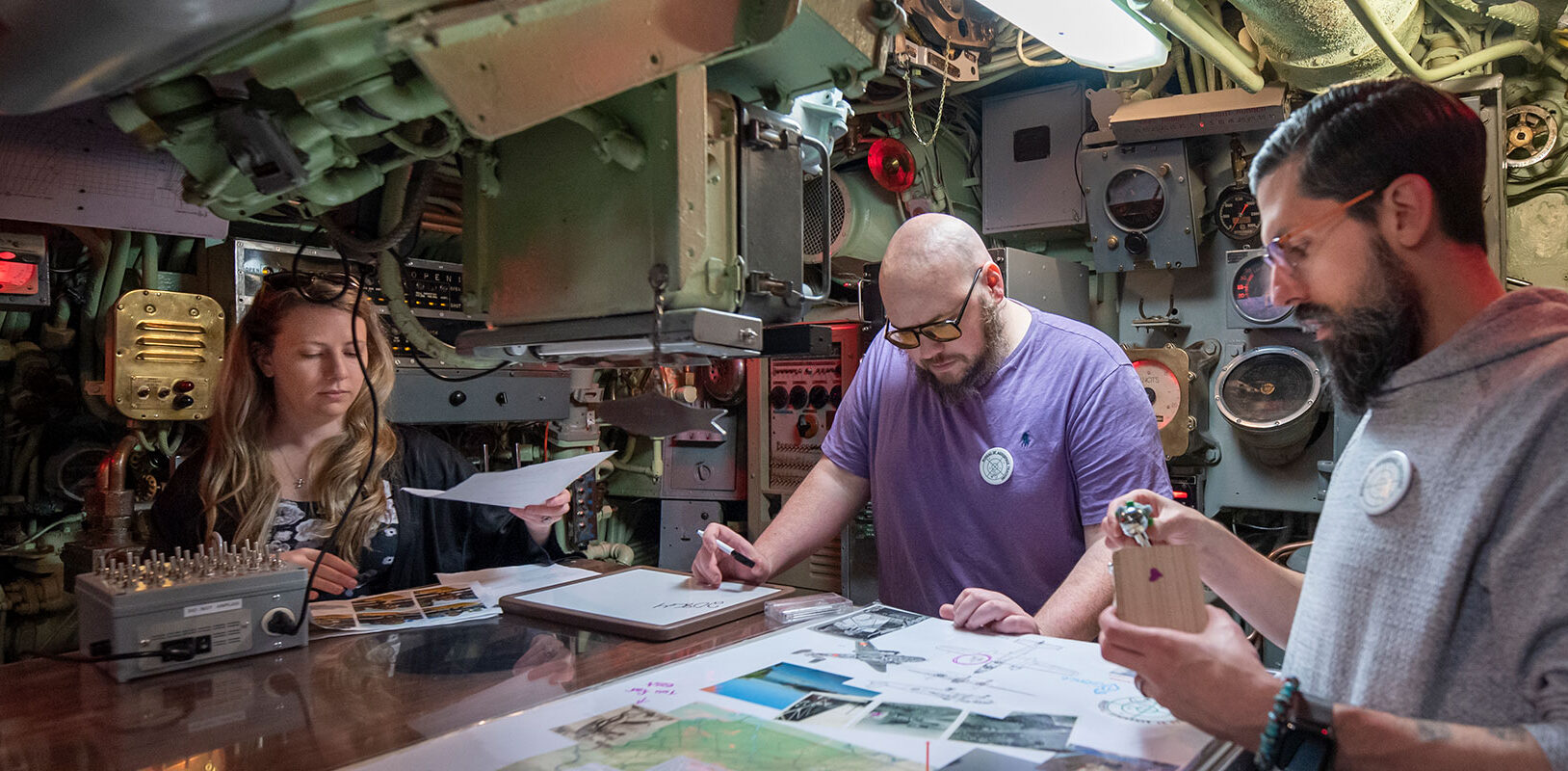It was a balmy Friday evening in late May when newlyweds Eric and Caitlin Schaefer and their friend, Dylan Thomas, made their way to the USS Requin to embark on a mission.
The details were still sketchy, but all three understood that they were about to be shut inside the Cold War-era submarine for the next hour and would work as a team to accomplish a simple goal: escape.
Moored on the banks of the Ohio River since 1990, this floating relic of the past has found new life as an “escape room.” Based on escape-the-room video games from the late ’80s, the first real-life version of today’s escape rooms debuted in 2007 in Japan. Since then, an estimated 50,000 escape rooms around the world have opened in malls, downtown storefronts, and even an aircraft carrier.
By all accounts, Requin is the only “escape room” on the planet that takes place inside a historic submarine.
For a former military man like Eric, who spent close to a decade in the Air National Guard, the opportunity to explore Requin in such an unusual way was hard to pass up.
“Compared to other escape rooms we’ve done,” the 36-year-old says, “this offered us a chance to be immersed in history.”
Carnegie Science Center’s floating exhibition was first deployed during the waning days of World War II. As the Cold War settled in, the Navy submarine was mustered into action for defense and scientific operations (some of its more than 5,000 dives remain classified to this day). Since it arrived at Carnegie Science Center more than three decades ago, Requin has been hosting visitor tours, Memorial Day remembrances, and other events as a way of teaching science, engineering, and military history.
Themed around the vessel’s storied past, Requin’s inaugural escape room launched in 2022. Since then, more than 850 brave souls have taken the plunge—some 180 this year alone, with additional sessions booked through early November. After that, the escape room adventures will be on hiatus until spring 2025.
“It still blows my mind how successful this has become,” Requin operations manager Maria Renzelli says. “Although escape rooms in general have exploded in popularity, ours offers something truly unique.”
No matter the location, these brick-and-mortar escape room games all share certain traits. Whether it’s fighting a zombie apocalypse or planning a bank heist, participants willingly become characters in the story. Time, however, is never on their side.
“It still blows my mind how successful this has become. Although escape rooms in general have exploded in popularity, ours offers something truly unique.”
Maria Renzelli, Requin operations manager
Players—usually small groups of friends—have about 60 minutes to work through a series of challenges. If they manage to complete the tasks—decode secret messages, unravel hidden clues, solve puzzles—before the clock winds down, they can brag of their great escape and go home winners.
Renzelli experienced her first escape room in 2017 and immediately saw the potential. “The whole time I couldn’t stop thinking about how cool this would be to do on Requin. After all, submarine life is all about problem-solving.”
The challenge for this particular night in May was locating the real-life infamous “Ghost Bomber.” Back in January 1956, during a routine training flight, a B-25 Mitchell bomber crashed into the icy waters of the Monongahela River. The plane was never found.
Greeted by Renzelli and her second-in-command, assistant manager Katie Schulze, the Schaefers and Thomas were ushered onto Requin’s deck. There, with the power vested in her by the Science Center, Schulze deputized the three as special agents of the Bureau of Aerospace Tracking. They were given official pins to commemorate their new status and told they had one hour to complete their undercover op.
The odds were on their side: Escape USS Requin: Pittsburgh Legends boasts about a 75 percent success rate. Still, the outcome was far from certain.
The Schaefers, both pharmacists, and Dylan, the general manager of a truck upfitting company, immediately snapped into action, double-timing it down the steep stairway that landed them in Requin’s forward torpedo room. The space was tight—the entire length of the sub is about 40 feet shorter than a football field, and at just 16 feet wide on the inside, significantly less expansive. And the air was thick and stagnant—punctuated by the odor of fuel, steel, and hydraulic fluid.
Undaunted by their physical environment, the team played to their strengths. Eric stepped up as the planner/investigator; Caitlin, the notetaker/math wiz; and 32-year-old Dylan, the scout/explorer.
“We were looking for numbers that could be used as codes and things that could be moved and then put together as part of a bigger puzzle,” says 31-year-old Caitlin.
Their strategy paid off. Ducking through hatchways, they moved from the officers’ quarters to the mess deck, the bunk room to the engine room, all the while deciding whether an item—like a coffee can, cassette tape, signal gun, maritime flag manual—was a clue or a red herring.
Their last stop was the stern room. As they surveyed the situation and calculated their final moves, their will to succeed was almost palpable. “We knew that if we panicked, we wouldn’t be able to get it done,” Eric says. “We had to remain calm and focused.”
With just 46 seconds to spare, victory was theirs—and that sense of calm quickly gave way to joy. “I jumped in the air and cheered,” Caitlin says. “It was just so exciting.”
Footnote: The specific details of the Schaefer-Thomas mission remain highly classified, as does the next iteration of Escape USS Requin.







